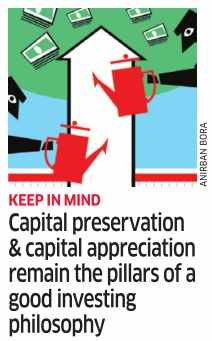Reblog: Investing is practice of bottom-up stock-picking
 Investing isn’t, and can’t be, about soothsaying market levels or about technical `timing’ of the markets. It also is not about finding that next new `wave’, `mega theme’ or `grand’ strategy; nor is it about dwelling on national or global economic macros.Investing remains a simple, rather dull and boring, uncluttered practice of bottom-up stock picking, with painstaking efforts and arduous discipline.
Investing isn’t, and can’t be, about soothsaying market levels or about technical `timing’ of the markets. It also is not about finding that next new `wave’, `mega theme’ or `grand’ strategy; nor is it about dwelling on national or global economic macros.Investing remains a simple, rather dull and boring, uncluttered practice of bottom-up stock picking, with painstaking efforts and arduous discipline.
The rest are popular sports, meant for amusement, occasional applause but not for adoption. If the investing skills were to degenerate to mere predicting of market levels and, hoisting the investing boat just at the right point of time such that rising tide lifts the boat, it would have been an embarrassing branch of knowledge. But fortunately , it is not.
Capital preservation and capital appreciation remain the pillars and cornerstone objectives of a good investing philosophy. While both are almost equally important, preservation precedes appreciation. That precedence has a telling effect on investing philosophy and strategy conceptualisation.
Preservation is not about guarding against day-to-day quotational changes. It is about strategising and arranging investing affairs such that, over time, risk of permanent loss of capital is eliminated. Subject to valuation, but if preservation is the only objective, that can be elegantly achieved by unstinted focus on quality: of the management, business and financial position.
Quality of management is not as nebulous an idea as it appears. Integrity , vision, execution, judicious capital allocation and capital distribution are the tell-tale signs of a great management. Quality of a business is that invisible, but real, quality which seamlessly completes cycle of turnover-profits-cash flows-investment returns; or, superiority , consistency and predictability of capital efficiency (return on capital employed). Quality financial position emanates from the quality business and quality management, but that can’t be just presumed; it should be verified to be so.
Long-term growth of real profits is a great proxy for the long-term investment returns, subject to capital efficiency and initial valuation. Growth emanates from the size of opportunity and management capability . Size of Opportunity is not about the size yesterday or today, but about potential to b e come bigger tomorrow. Meaningful, sustained, durable growth of cashflows separates equity investing from fixed-income one. Absence of growth blurs the distinction. A quality business bought at intrinsic worth gives investor underly ing economic returns but bought at discount (margin of safety) provides investment returns superior to the economic returns.
Many a professional investing careers are consumed in agonising over incessant peer, period or benchmark RBAN BORA comparisons, which professional in vesting, unfortunately , can’t escape, but essentially , investing is about ab ANI solute returns. Relativity is merely an interesting (and often, traumatising) sideshow and actually an outcome of how well the philosophy of absolute is conceptualised and practiced.
In theory , concentration of investments is a valuable idea; in practice, the consequences could often be un intended ones. Undue portfolio diversification represents, at best, mediocrity and at worse, intellectual confusion. Equally, idea of undue concentration, made popular (but not always practised) by many , often represents exaggerated romanticism and implies undertaking un assumed level of risk, if not represent ing hubris and sense of invincibility -hardly a virtuous combination for a durable and productive investing success. Swiftness and magnitude of market reaction (in altering the firm value) to any disruptive change, is disconcerting.
Unforeseen or unforeseeable events can expose a highly concentrated portfolio to obliteration, at worst, and mental scarring, at best. Prudence and wisdom demand a judicious balance between intellectually-elegant concentration and wise diversification.
Inclusion is a valuable idea in social and political lexicon. But in the investing world, exclusion is the key for success. That demands, ab initio, repelling of a vast multitude of mediocre businesses managements, and focusing on a smaller universe left, akin to filtering of large amount of dross for focusing on the remaining fine particles of gold dust, for final beneficiation.
Investing is both an envisioned science and a practiced craft, a bit more of the latter than former. Science consists of reasonable intellect for understanding the innards real character of diverse businesses and having valuations skills to discern their intrinsic worth. Art consists of being disciplined to buy only quality , and staying away from fickle fashions and even overpriced quality.Wisdom is the most important of all: mental toughness and conditioning to stay the course, having done all the prior hard work and to not temperamentally flirt with the investments.
The original article is authored by Bharat Shah, ED, ASK Group and appeared on economictimes.com. It is available here.





